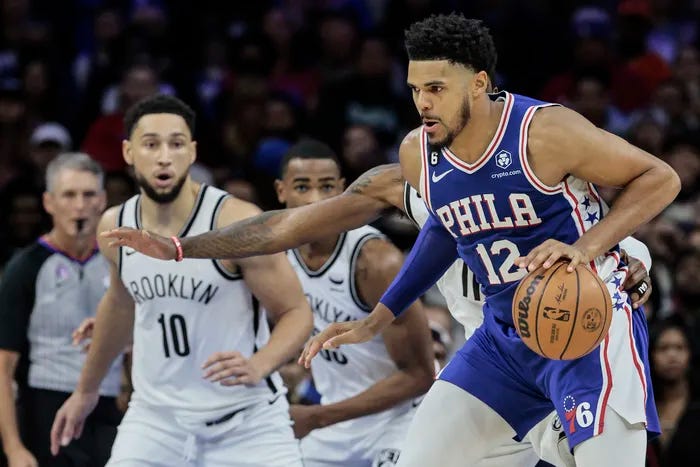Nets’ Embarrassing Loss To Shorthanded Philly Can Be Traced To Effort And Scheme
Every NBA team produces stinkers over the course of a marathon season. Usually, they come on the back end of a back-to-back or other dense cluster of games. The team could be shorthanded, either due to injuries or having key players subjected to the cursed “load management” requirements. Or it could just be one of those awful nights where their shots wouldn’t fall even if the rims were expanded.
The Nets had none of those issues in Tuesday’s 115-108 loss in Philadelphia. In fact, it was the Sixers who were depleted, with All Stars Joel Embiid and James Harden plus rising star Tyrese Maxey all watching the return of hated former teammate Ben Simmons while wearing street clothes on the sidelines. Sorry, but Brooklyn’s loss of reserve Yuta Watanabe (hamstring tightness) paled in comparison.
It didn’t take a forensic scientist to diagnose the Nets’ problem—they actually shot the ball well enough (55%, including 32% from deep) to win, but gave Philadelphia the space to knock down 16-of-32 three-pointers and convert 20 offensive rebounds into 25 second-chance points. Combined, those two categories yielded a 39-point advantage for the Sixers.
As always with the Nets, their defensive struggles are directly the result of effort and scheme. Head Coach Jacque Vaughn mentioned in his postgame remarks that he will be meting out playing time based on who’s playing hard, but does that mean he will bench his stars Kevin Durant and Kyrie Irving? They were as responsible as anyone for not respecting Tuesday’s game.
And Vaughn has his own culpability to sort out. Since his elevation from assistant coach after the Nets and Steve Nash “mutually” parted ways on November 1, Vaughn simplified the game plan by having the defense switch all screens. Overall, it has worked well in the short term—Brooklyn is 10th in the league in defensive efficiency over Vaughn’s first 11 games, and that included an outrageous defensive performance in Sacramento where the Nets surrendered 153 points, the most ever in regulation in franchise history.
Since Philly was missing their playmakers, they were coached exceptionally well by Doc Rivers to get the Nets to switch into favorable matchups, where they could attack to force help, leaving open three-point shooters and unchecked bodies underneath to swallow up rebounds. It must have been frustrating for Brooklyn to capably guard for the first 16 seconds or so of the 24-second shot clock, only to be undone by breakdowns. The Sixers shot 15-for-30 (including 9-of-13 from three-point distances) in the last seven seconds of the shot clock. They made 6-of-8 three-pointers as the clock ticked to four seconds or under.
Too often the Nets overhelped when it wasn’t necessary, leaving their men wide open to fire away uncontested—according to NBA.com’s tracking, 14 of the Sixers’ three-point attempts were taken with the nearest Nets defender at least six feet away. Brooklyn was lucky Philly only made six of those, though the Sixers went 9-for-15 on what the site deemed “open” shots with 4-to-6 feet of room. Put another way, just three of their opponent’s 32 three-point attempts were somewhat contested.
Again, effort and scheme.
When the Sixers’ ball/player movement wasn’t leading to quality looks, they could always just target Nets wing Joe Harris, who had a brutal outing on both ends. Philly went after Harris every chance they could in the fourth quarter, usually setting screens so that he was matched up with Sixers forward Tobias Harris. Per NBA.com, the Sixers went 6-for-6 with Harris as the closest defender in a fourth quarter that saw them turn a tight game into a double-digit lead.
When Harris is his usual lights-out shooting self, you can live with some defensive giveback. When he goes 1-for-8, including 1-for-7 on three-pointers, you have to ask what Vaughn was seeing that made him leave Harris out there to get destroyed.
The Nets actually played the Sixers even in the nearly 13 minutes Simmons shared the court with Nic Claxton despite the glaring spacing challenges they presented. When separated, though, their switching often left them stuck out on the perimeter and unable to contribute assistance on the backboards, further complicating the team’s rebounding efforts that was already hamstrung by a relative size disadvantage.
Like I forewarned, good teams with good coaches will continue to exploit these soft spots in the Nets’ defensive scheme. When you combined that with a substandard effort, you got perhaps one of the most embarrassing results of the Nets’ superstar era.



